
Umwelttests (Klima-, Temperatur, Schock, Schwingungs-Prüfung)
Schwingungs- Vibrations- Schocktest nach Normen
- EN 60068-2-6 Schwingungen sinusförmig
- EN 60068-2-64 Schwingungen Rauschen
- EN 60068-2-27 Schockprüfung
- EN 60068-2-29 Dauerschockprüfung
- ISO 90022-3 Schwingen, Schocktest, Optik und optische Instrumente
MIL-STD 810H
- Method 514.6 Vibrationstests
- Method 516.6 Shock
- Method 519.6 Gunfire
- Standard Vibration
- Robust Vibration
- High Level Short Duration Vibration
- Simulation von Sonneneinstrahlung (UV)
RTCA DO 160 Environmental Conditions and Test Procedures for Airborne Equipment:
- Section 4 – Temperature and Altitude
- Section 5 – Temperature Variation
- Section 6 – Humidity
- Section 7 – Operational Shocks and Crash Safety
- Section 8 – Vibration
- Section 15 – Magnetic Effect
- Section 16 – Power Input
- Section 17 – Voltage Spike
- Section 18 – Audio Frequency Conducted Susceptibility – Power Inputs
- Section 19 – Induced Signal Susceptibility
- Section 20 – Radio-frequency Susceptibility (Radiated and Conducted)
- Section 22 – Lightning Induced Transient Susceptibility
- Section 25 – Electrostatic Discharge (ESD)
Temperaturtest nach Normen
- EN 60068-2-1 Kälte
- EN 60068-2-2 Trockene Wärme
- EN 60068-2-14 Temperaturwechsel
- EN 60068-2-13 Niedriger Luftdruck
Klimatest nach Normen
- EN 60068-2-30 Feuchte Wärme, zyklisch
- EN 60068-2-38 Temperatur/Feuchte, zyklisch
- EN 60068-2-78 Feuchte Wärme, konstant
Korrosionstest nach Norm
EN ISO 6270-2 Bestimmung der Beständigkeit gegen Feuchtigkeit - Teil 2: Kondensation Beanspruchung in einer Klimakammer mit geheiztem Wasserbehälter
Druck und Unterdruck
RTCA DO160
- MIL-STD 810G
- Method 500.5 Low Pressure (Altitude)
- Method 501.5 High Temperature
- Method 502.5 Low Temperature
- Mil-Std 883 D
- Method 1001 Reduced Preasure
- Method 1010.7 Temperatur cycling